+8
mk1rceme
Perth-Regiment(M.G.)
Infanteer
lorne19
edstorey
48th
zekehp
Wgrenadier
12 posters
Field Guide to Canadian P37 Webbing Modifications (with pictures)

lorne19- Member
- Posts : 423
Join date : 2011-08-22
Age : 37
Location : Canada
This is a great thread, a lot of great info. I'm curious Ed, is that bino case career a Britsh or Canadian example?

Wgrenadier- Moderator
- Posts : 289
Join date : 2013-02-16
Here is a photo of 48th's 1940-dated binocular case with side buckles. If the buckles were added at some later date, they sure did an excellent job of it!



lorne19- Member
- Posts : 423
Join date : 2011-08-22
Age : 37
Location : Canada
I have an example of a 1940 bino case made by Z.L&T without buckles, but I have also seen them with. Also all the examples that i've seen appeared to be factory done rathee than modifications.

Wgrenadier- Moderator
- Posts : 289
Join date : 2013-02-16
Here is some evidence that the Canadian bayonet frog was retrofitted with a split upper loop sometime in 1942-1943...
The frog on the left is marked "Z.L.&T. Ltd. 1942" and demonstrates that unmodified frogs were produced into 1942. The modified middle frog is marked "GEW 1943" and is a uniform shade of khaki throughout. The frog on the right appears to be very faintly marked "M.S.&U.Ltd. 1941" and has a split upper loop in a noticeably different shade of khaki.






The frog below is marked "GEW 1941" and also has an upper split loop in a different shade of khaki (difficult to see in these pictures). The close up shot reveals that the stitching of the upper loop is a different shade and pattern than the rest of the frog and indicates alteration.


The frog on the left is marked "Z.L.&T. Ltd. 1942" and demonstrates that unmodified frogs were produced into 1942. The modified middle frog is marked "GEW 1943" and is a uniform shade of khaki throughout. The frog on the right appears to be very faintly marked "M.S.&U.Ltd. 1941" and has a split upper loop in a noticeably different shade of khaki.






The frog below is marked "GEW 1941" and also has an upper split loop in a different shade of khaki (difficult to see in these pictures). The close up shot reveals that the stitching of the upper loop is a different shade and pattern than the rest of the frog and indicates alteration.



lorne19- Member
- Posts : 423
Join date : 2011-08-22
Age : 37
Location : Canada
I think its time to jump start this thread, some really good info and pics were starting to come out. Heres a basic set of P37 webbing from my collection.



Wgrenadier- Moderator
- Posts : 289
Join date : 2013-02-16
Hey Guys!
48th graciously agreed to let me post a set of pictures from part of his extensive collection. They are quite interesting pieces of Canadian manufactured webbing that show a great deal of production variations! I will list them chronologically and note any production modifications...
1st Pattern Braces (ZL&T 1940) - note the one-piece construction and brass chapes

Music Pouch (MS&U 1940) - Issued to musicians to store their music in, examples are known from both ZL&T and MS&U

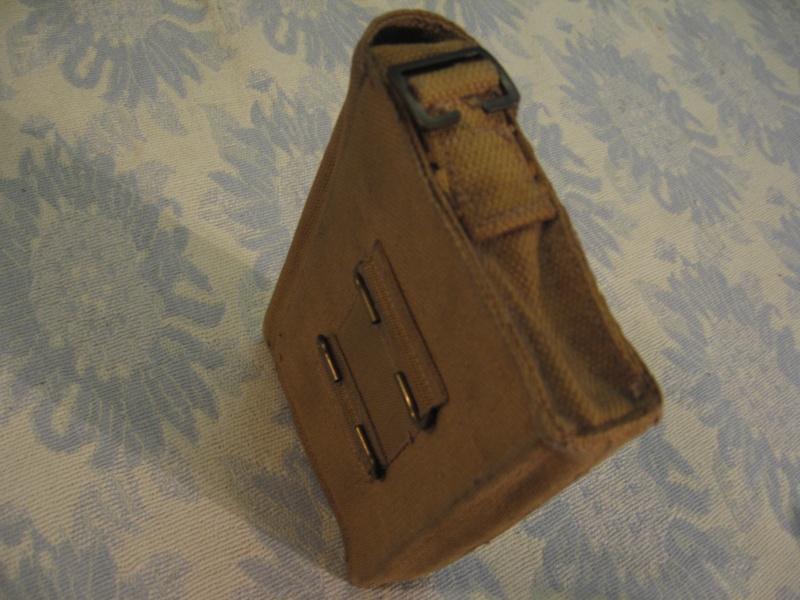
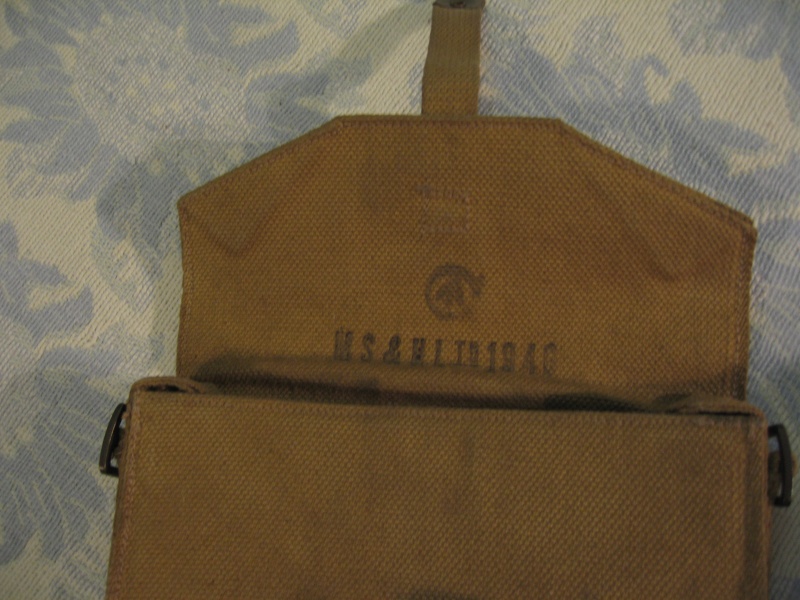
Flare Gun Holster (ZL&T 1941) - note the early brass fittings (we can assume that the snap is pebble grained as well)

Pliers Frog (ZL&T 1942)
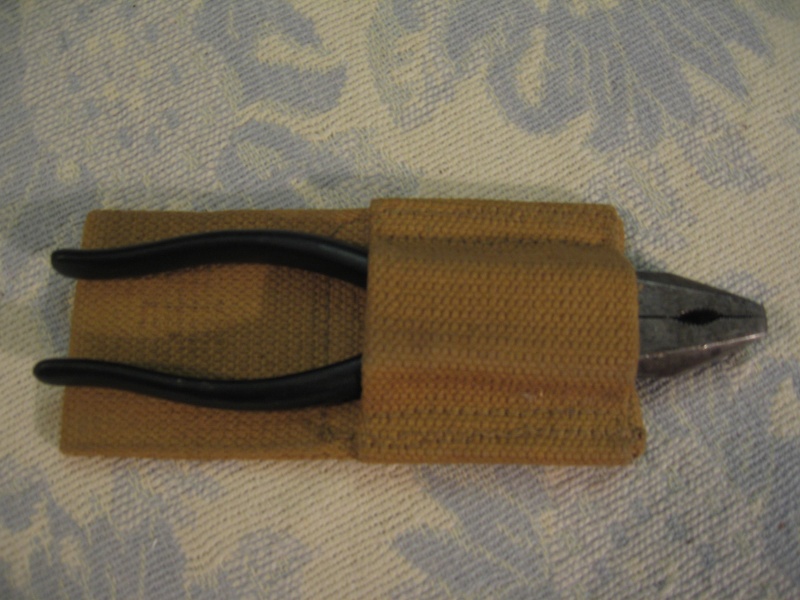
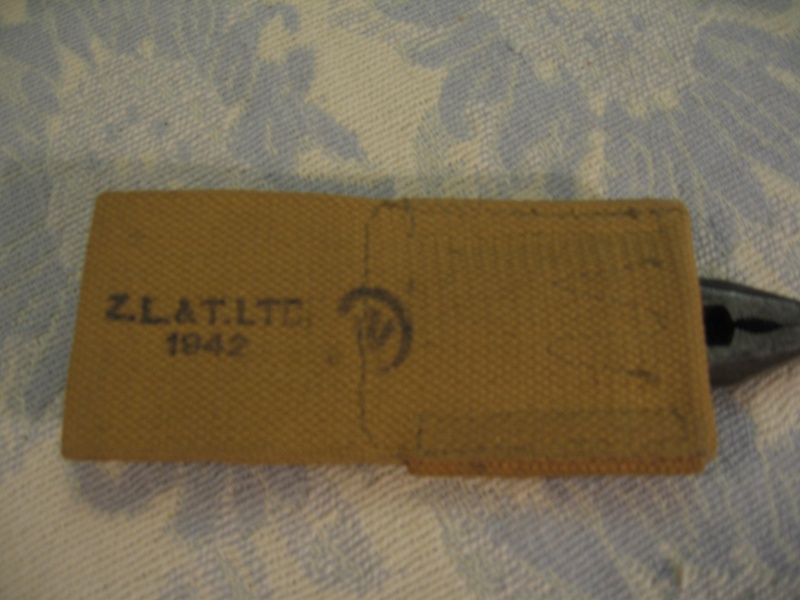
Wire Cutter Frog (ZL&T 1942) - note that the pebble grained snap is indicative of manufacture in early 1942


L-Strap Modification (MS&U 1943) - note here the conversion of brass fittings to 'battle brass' in 1943

L-Strap Modification (MS&U 1943) - note the interesting difference in length of the neck of the L-straps, a modification that followed the conversion to metal fittings in 1943
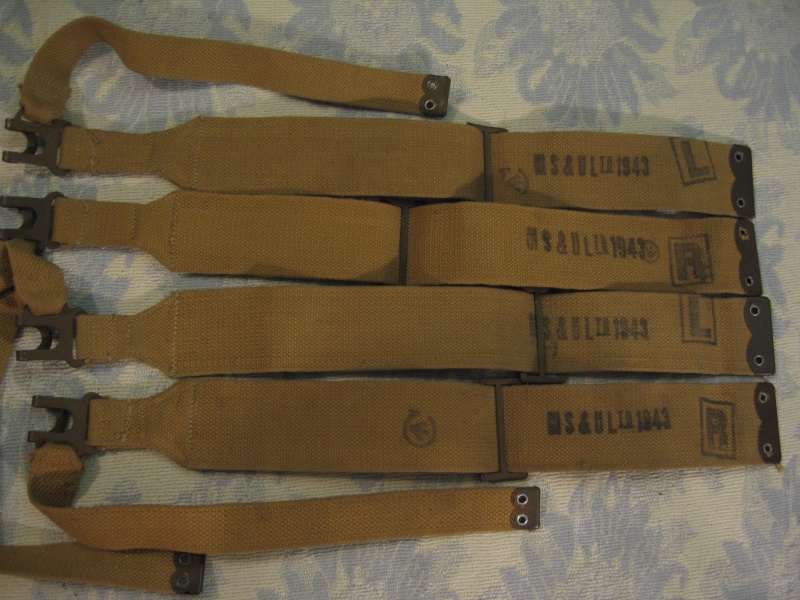

L-Strap Modification (ZL&T 1943) - note the elimination of the tapering as well as the mix of brass and metal fittings

Small Pack (MS&U 1943) - note the use of metal fittings
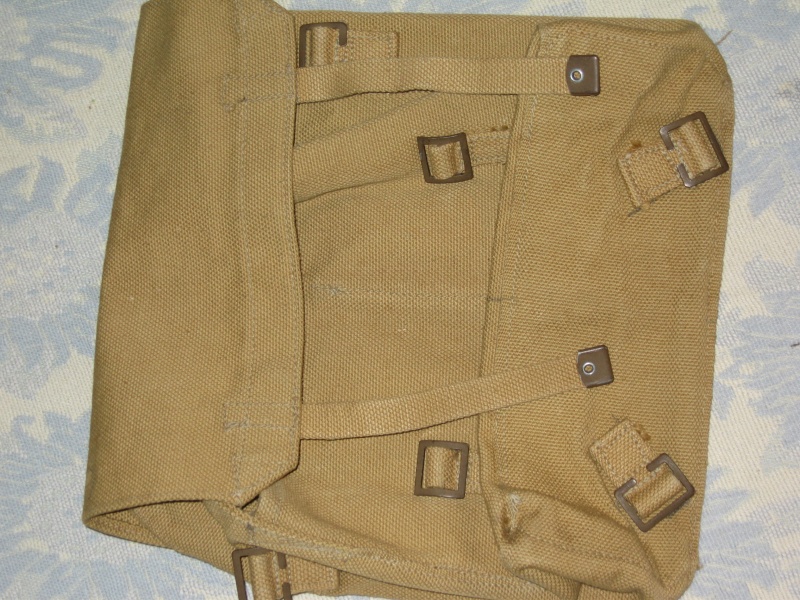
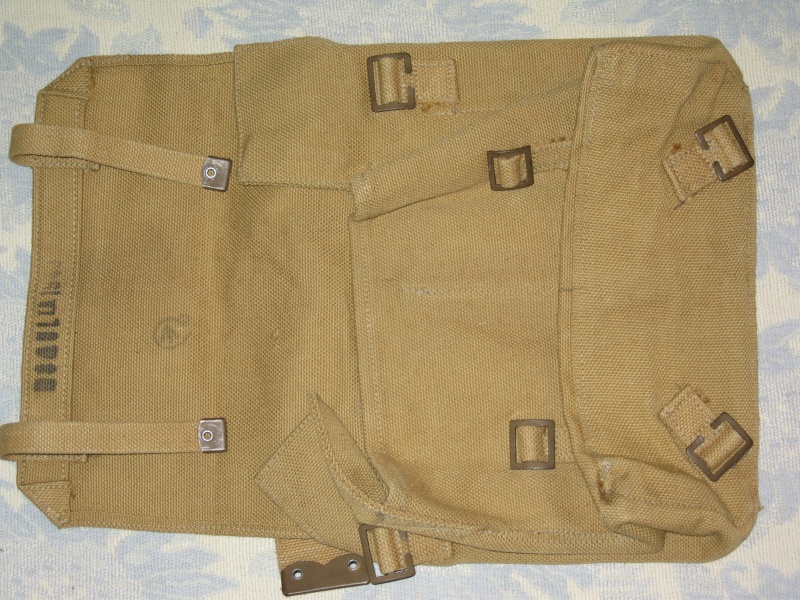
Brass Fittings with Black-Painted Eyelets (MS&U 1943) - this small pack and l-strap came from Australia and may represent a unique variation in one of the orders Canada filled for her ally

Signals Satchel (ZL&T 1943) - note the black steel fittings that appeared on some items made by ZL&T in 1943 as well as the multi-piece brace construction
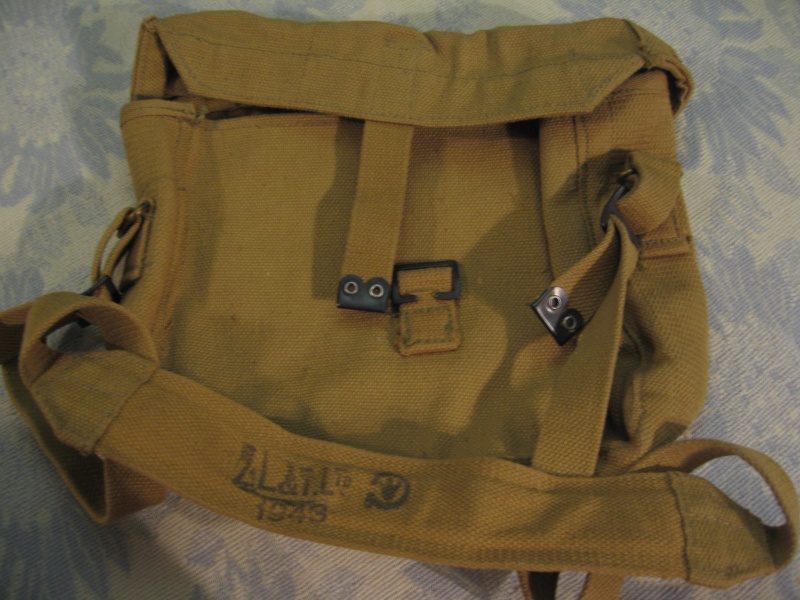
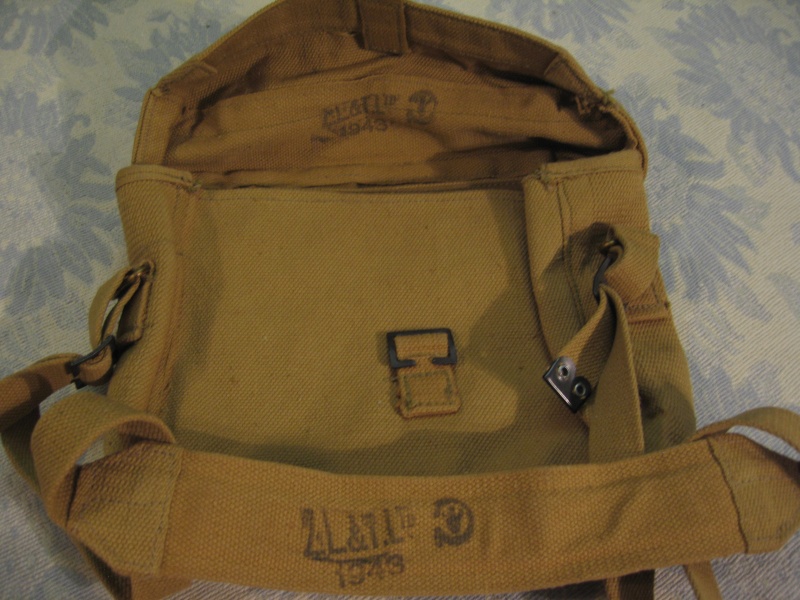
Light Gasmask Bag (ZL&T 1943) - note the black steel fittings

Unknown Strap (MS&U 1944)
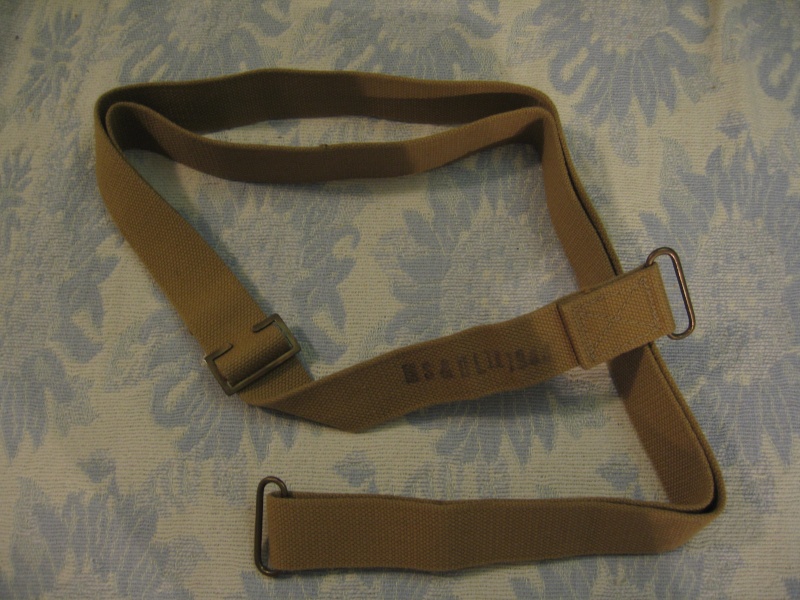
Brace Modification (ZL&T 1944) - these odd braces may have been an economy measure to eliminate the need for brace adapters. Note the multi-piece construction and resin-impregnated tips
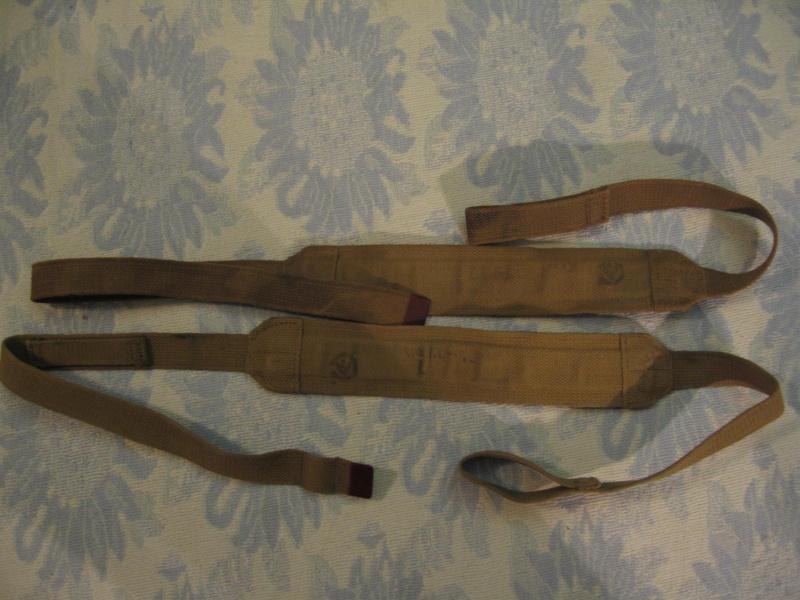
Signal Satchels (ZL&T 1945 & JELCO 1944) - note the canvas (instead of webbing) construction as well as the switch from a metal chape on the Jelco satchel to the resin-impregnated tip on the one made by ZL&T in the following year

2 Inch Mortar Wallet (ZL&T 1945) - note the resin-impregnated tips
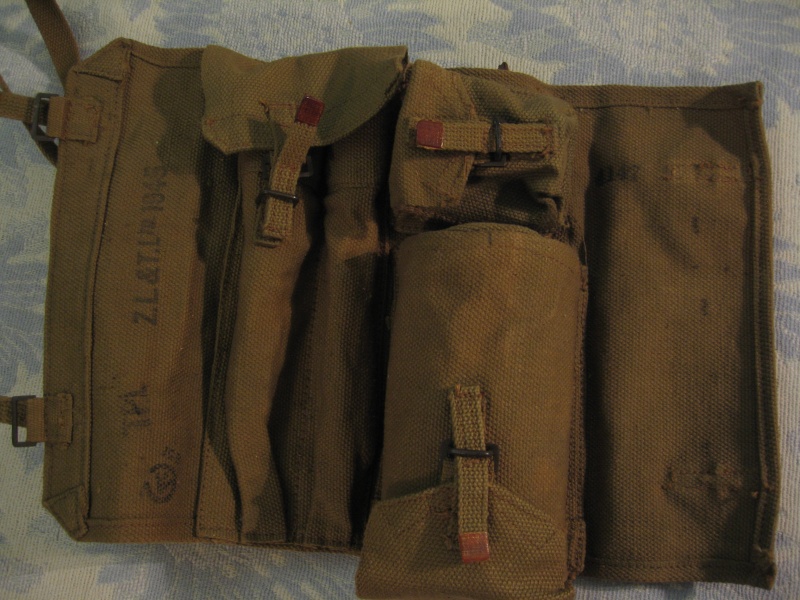
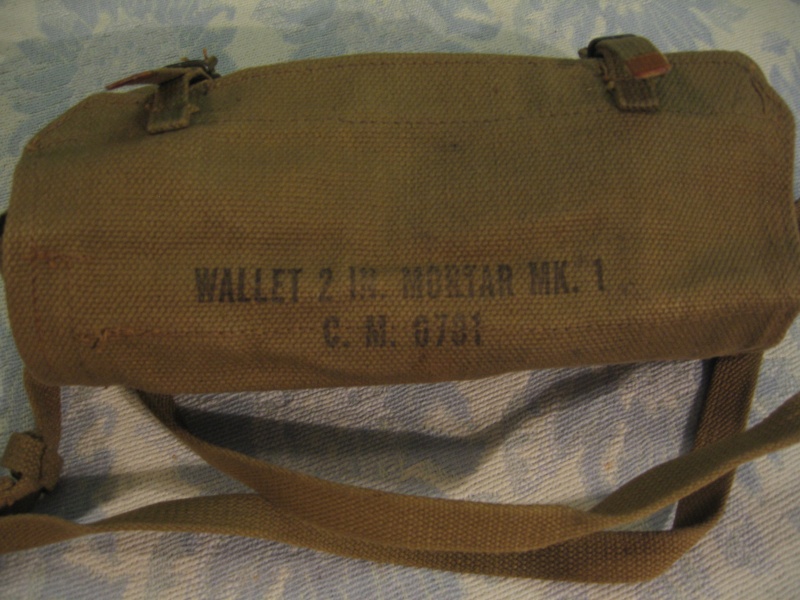

48th graciously agreed to let me post a set of pictures from part of his extensive collection. They are quite interesting pieces of Canadian manufactured webbing that show a great deal of production variations! I will list them chronologically and note any production modifications...
1st Pattern Braces (ZL&T 1940) - note the one-piece construction and brass chapes

Music Pouch (MS&U 1940) - Issued to musicians to store their music in, examples are known from both ZL&T and MS&U



Flare Gun Holster (ZL&T 1941) - note the early brass fittings (we can assume that the snap is pebble grained as well)

Pliers Frog (ZL&T 1942)


Wire Cutter Frog (ZL&T 1942) - note that the pebble grained snap is indicative of manufacture in early 1942


L-Strap Modification (MS&U 1943) - note here the conversion of brass fittings to 'battle brass' in 1943

L-Strap Modification (MS&U 1943) - note the interesting difference in length of the neck of the L-straps, a modification that followed the conversion to metal fittings in 1943


L-Strap Modification (ZL&T 1943) - note the elimination of the tapering as well as the mix of brass and metal fittings

Small Pack (MS&U 1943) - note the use of metal fittings


Brass Fittings with Black-Painted Eyelets (MS&U 1943) - this small pack and l-strap came from Australia and may represent a unique variation in one of the orders Canada filled for her ally

Signals Satchel (ZL&T 1943) - note the black steel fittings that appeared on some items made by ZL&T in 1943 as well as the multi-piece brace construction


Light Gasmask Bag (ZL&T 1943) - note the black steel fittings

Unknown Strap (MS&U 1944)

Brace Modification (ZL&T 1944) - these odd braces may have been an economy measure to eliminate the need for brace adapters. Note the multi-piece construction and resin-impregnated tips

Signal Satchels (ZL&T 1945 & JELCO 1944) - note the canvas (instead of webbing) construction as well as the switch from a metal chape on the Jelco satchel to the resin-impregnated tip on the one made by ZL&T in the following year

2 Inch Mortar Wallet (ZL&T 1945) - note the resin-impregnated tips



Last edited by Wgrenadier on Wed Sep 04, 2013 10:44 pm; edited 1 time in total

Wgrenadier- Moderator
- Posts : 289
Join date : 2013-02-16
Does anybody know if the 4 digit codes (see below) that frequently appear on Canadian webbing are inspector marks?
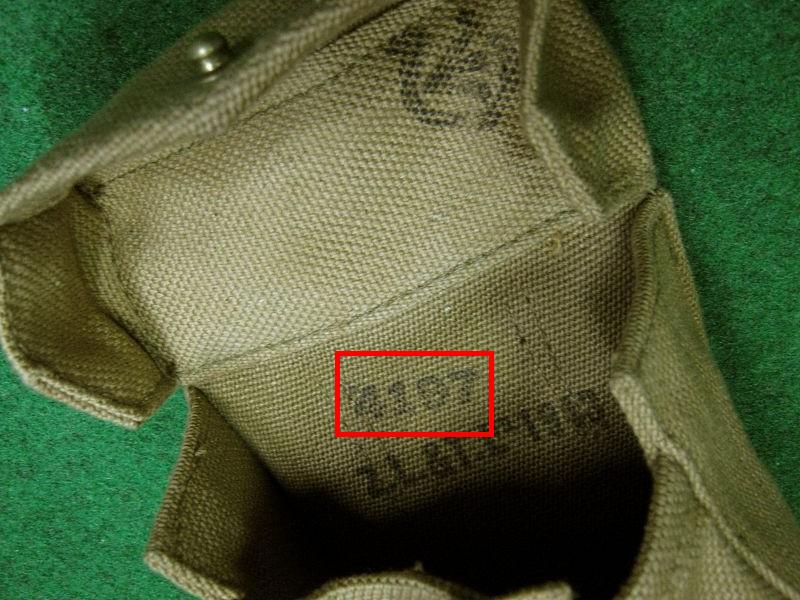

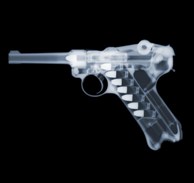
Infanteer- Member
- Posts : 820
Join date : 2009-12-11
Wow!!! Those are some of the best quality stamped maker's marks I've seen. It's not common to find webbing/canvas items with such crisp, dark stampings. Thanks for sharing.
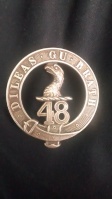
48th- Member
- Posts : 287
Join date : 2012-12-05
Thanks for posting the pictures for me Wgrenadier, my guess on the 4 digit numbers are either production run/batch numbers or inspectors numbers.

48th- Member
- Posts : 287
Join date : 2012-12-05
In regards to the pictures that Infanteer posted for me I have a few questions for fellow collectors:
1) Does any one have any information on what the unknown Strap (MS&U 1944) is used for? It is about 4' long.
2) Does any one have in there collection or any information on the strance Z.L.&T. 1944 braces varation? I have been unable to find any more of the braces and I have not seen any information about them in the books I have.
1) Does any one have any information on what the unknown Strap (MS&U 1944) is used for? It is about 4' long.
2) Does any one have in there collection or any information on the strance Z.L.&T. 1944 braces varation? I have been unable to find any more of the braces and I have not seen any information about them in the books I have.

Perth-Regiment(M.G.)- Member
- Posts : 86
Join date : 2013-03-04
Age : 31
Location : Ottawa, Ontario, Canada
Dose anyone know where I can buy a Wire Cutter Frog for my wire cutters and ww2 Pliers for my Pliers Frog?

Wgrenadier- Moderator
- Posts : 289
Join date : 2013-02-16
Thanks 48th! I hadn't thought of production run/batch numbers before, but it makes sense!

Wgrenadier- Moderator
- Posts : 289
Join date : 2013-02-16
Karkee Web writer, Rog Dennis, gave the following answer when asked how the early war binocular carriers were attached to web equipment sets...
"The strap & buckle arrangement could allow for buckling to dees of W.E., I.O. Strap, back adjustment and to the dees on the Attachments, brace, which officers might still have had from prewar private purchases. This pattern had integrated bino / compass and holster / ammo assemblies. For expediency, these were sometimes separated, fitted with “C” hooks, so that a replica of the new Patt. ’37 standard was effected. Why waste what you’ve spent good money buying?! However, why have the Case flapping around, when it has “C” hooks to attach to the belt?
More plausibly, it could also attach, with the strap & buckle, to the Sling with dees, for officer's Haversacks & Water Bottles that were add-on items associated with Sam Browne Equipment. Once again, officers may well have purchased these and a sling, so why waste it?! It's just a convenient way of carrying just the binos - nothing else, say whilst observing manoeuvres, etc.€
http://www.karkeeweb.com/patterns/officers/w_e_o/1919/components/belts/html/belt_out.html
http://www.karkeeweb.com/patterns/officers/w_e_o/1919/components/belts/html/ba_2_in.html
OR (just using buckles) to a Patt. '37 W.E. Brace. It was NOT part of Patt. '37 W.E., so should've read Carrier, for Case, binocular, W.E. Patt. ’37"
"The strap & buckle arrangement could allow for buckling to dees of W.E., I.O. Strap, back adjustment and to the dees on the Attachments, brace, which officers might still have had from prewar private purchases. This pattern had integrated bino / compass and holster / ammo assemblies. For expediency, these were sometimes separated, fitted with “C” hooks, so that a replica of the new Patt. ’37 standard was effected. Why waste what you’ve spent good money buying?! However, why have the Case flapping around, when it has “C” hooks to attach to the belt?
More plausibly, it could also attach, with the strap & buckle, to the Sling with dees, for officer's Haversacks & Water Bottles that were add-on items associated with Sam Browne Equipment. Once again, officers may well have purchased these and a sling, so why waste it?! It's just a convenient way of carrying just the binos - nothing else, say whilst observing manoeuvres, etc.€
http://www.karkeeweb.com/patterns/officers/w_e_o/1919/components/belts/html/belt_out.html
http://www.karkeeweb.com/patterns/officers/w_e_o/1919/components/belts/html/ba_2_in.html
OR (just using buckles) to a Patt. '37 W.E. Brace. It was NOT part of Patt. '37 W.E., so should've read Carrier, for Case, binocular, W.E. Patt. ’37"

Wgrenadier- Moderator
- Posts : 289
Join date : 2013-02-16
Just came across the following L-straps from an eBay seller in Australia.
They look very similar in construction to the 2nd pattern braces made by ZL&T LTD, so I wonder if they are some intermediate form from 1943 that preceded the type with no reduction?

They look very similar in construction to the 2nd pattern braces made by ZL&T LTD, so I wonder if they are some intermediate form from 1943 that preceded the type with no reduction?


Wgrenadier- Moderator
- Posts : 289
Join date : 2013-02-16
This early war set of Canadian-made Pattern 1937 officer's webbing was listed on eBay a while back, and included a 1939 dated (maker's mark listed as unreadable) .38 holster. This particular holster is very interesting because it has been user modified to accommodate a larger-frame revolver with the addition of a closure strap extension.
I believe this modification foreshadows Canada's official introduction of the large-frame holster in 1942.
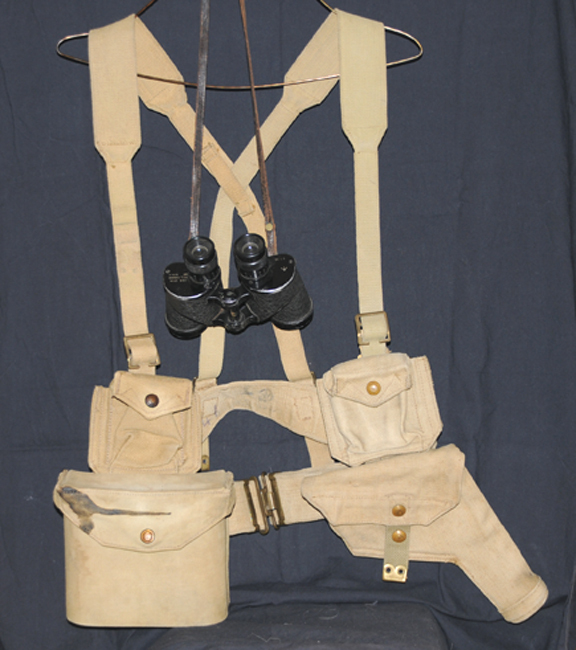
I believe this modification foreshadows Canada's official introduction of the large-frame holster in 1942.


Wgrenadier- Moderator
- Posts : 289
Join date : 2013-02-16
Some pictures of an early war set of Canadian manufactured Pattern 1937 Webbing.
Complete set in Field Service Marching Order

Interior view

Basic pouches marked "Z.L.&T.LTD. 1942" - Note the ballistite loops
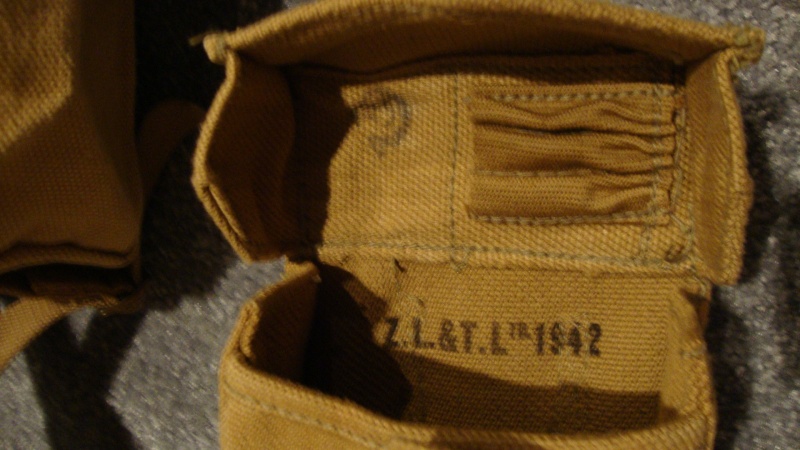
Right side - Note the 1-inch wide basic pouch closure strap and front closure water bottle carrier
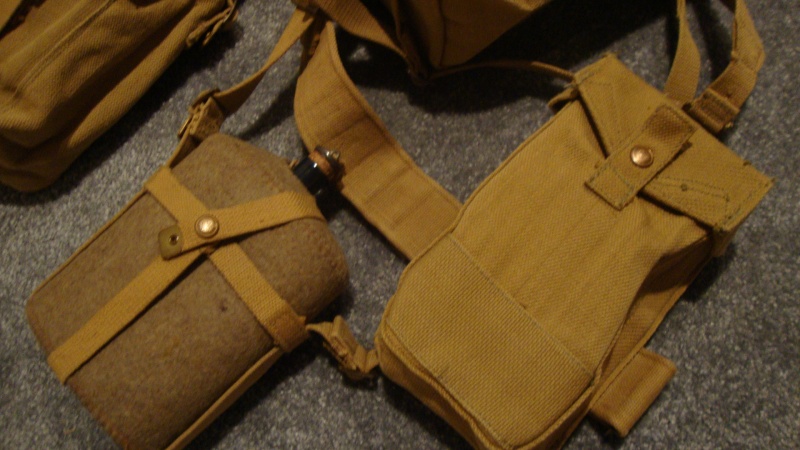
Water bottle carrier marked "Z.L.&T.LTD. 1942"
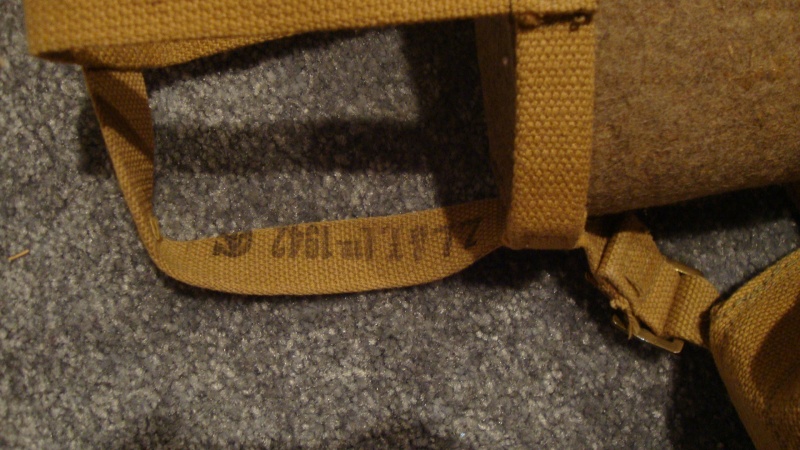
Haversack marked "Z.L.&T.LTD. 1942"
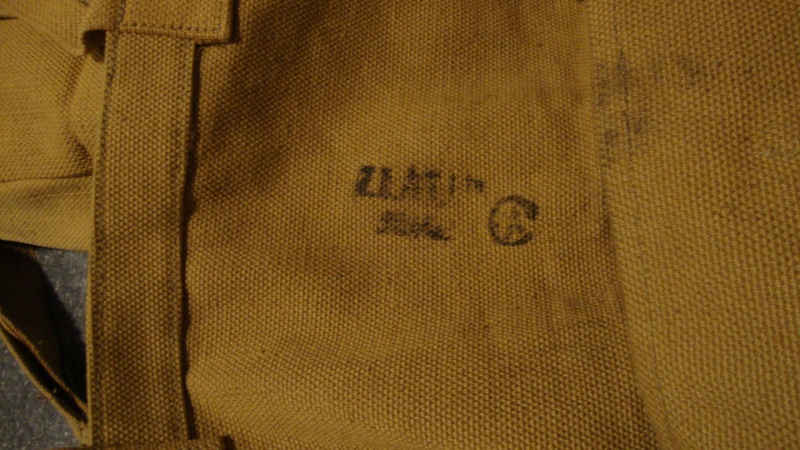
Canadian mess tin cover in typical greenish shade of Canadian khaki drill
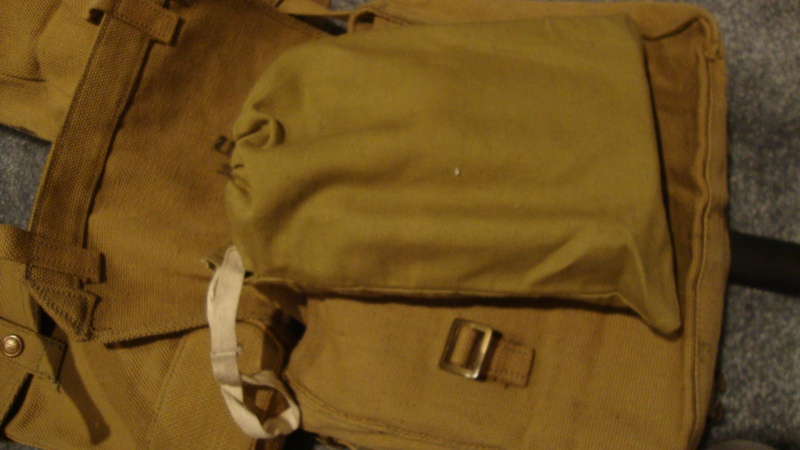
Canadian government ownership mark on mess tin cover
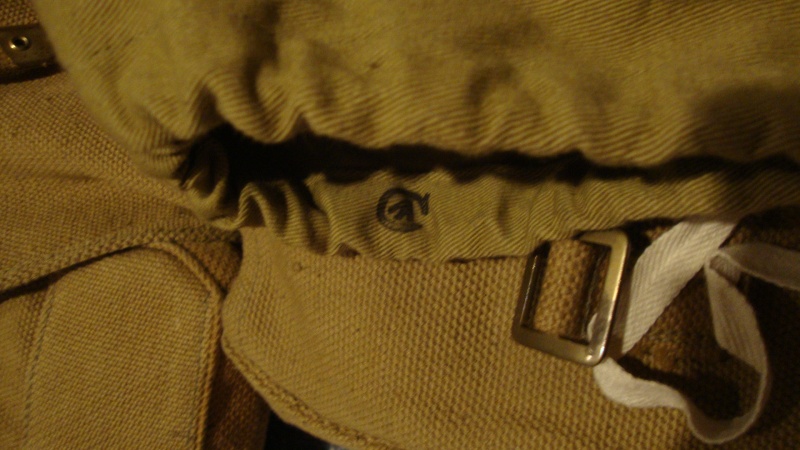
Mess tin cover made by TAPATCO and marked "THE AMERICAN PAD & TEXTILE CO. - CHATHAM - ONT. 1942"
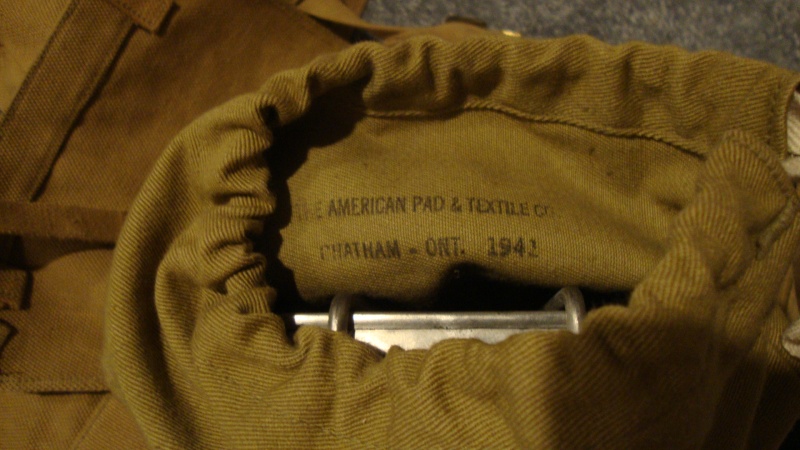
Haversack interior showing dividers for mess tin/water bottle as well as the inspection/production number
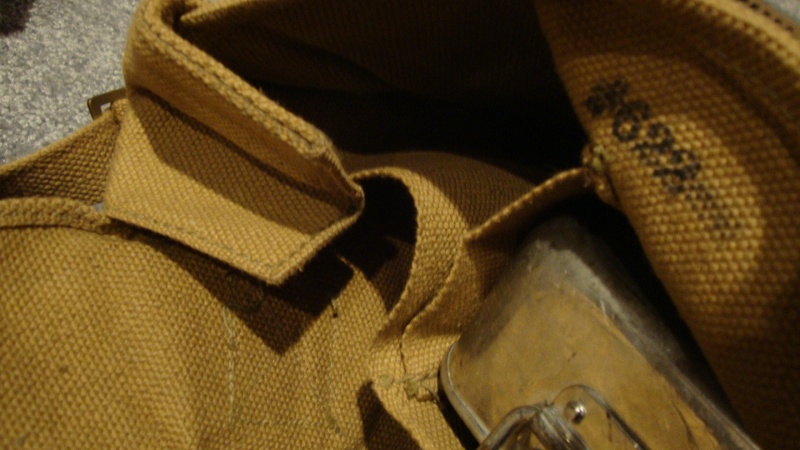
Large pack marked "Z.L.&T.LTD. 1942"

Support straps marked "Z.L.&T.LTD. 1943"

Back of basic pouch showing "SMALL" marking

Belt Marked "Z.L.&T.LTD. 1942 - L - 56" - Note that large sized belts could accommodate sizes up to 56-inches

Bayonet frog made by Granby Elastic Webbing and marked "GEW 1942"

Left brace marked "Z.L.&T.LTD. 1942 - L"
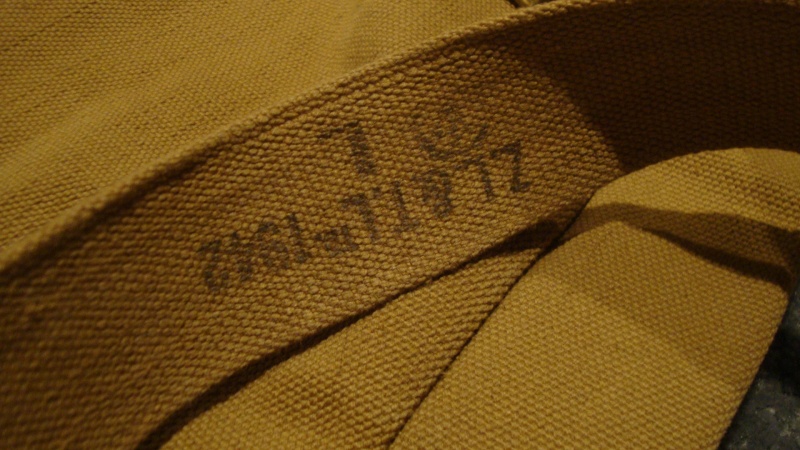
Right brace marked "Z.L.&T.LTD. 1942 - R"
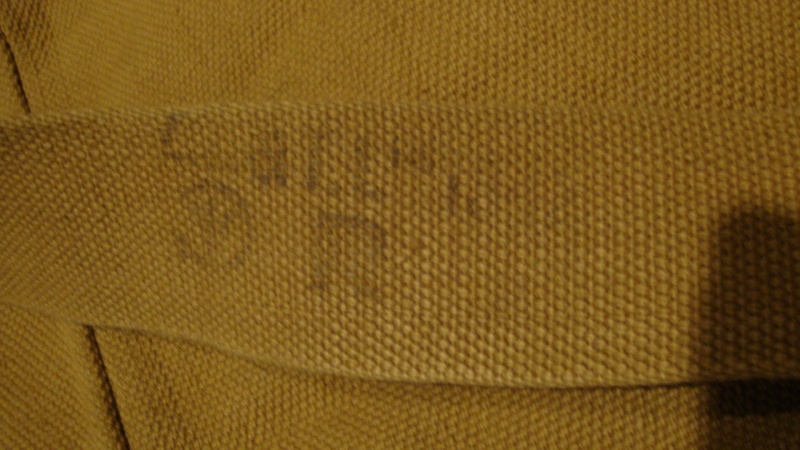
Left L-strap marked "Z.L.&T.LTD. 1942 - L"
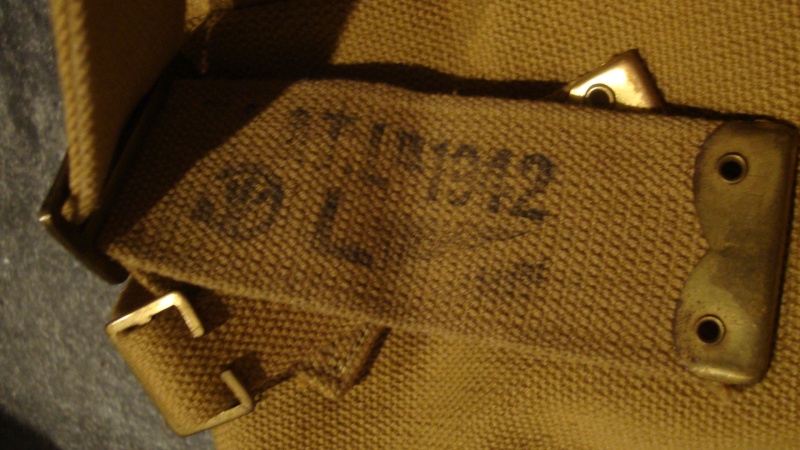
Right L-strap marked "Z.L.&T.LTD. 1942 - R"
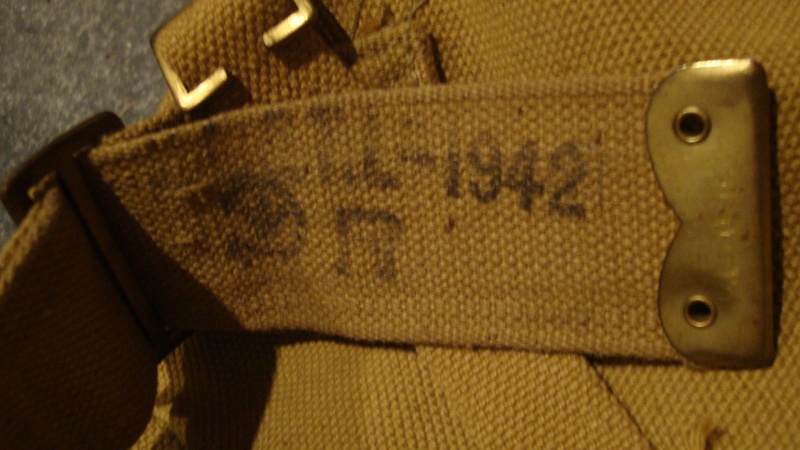
British & Canadian Emergency S.A.A. Bandoliers
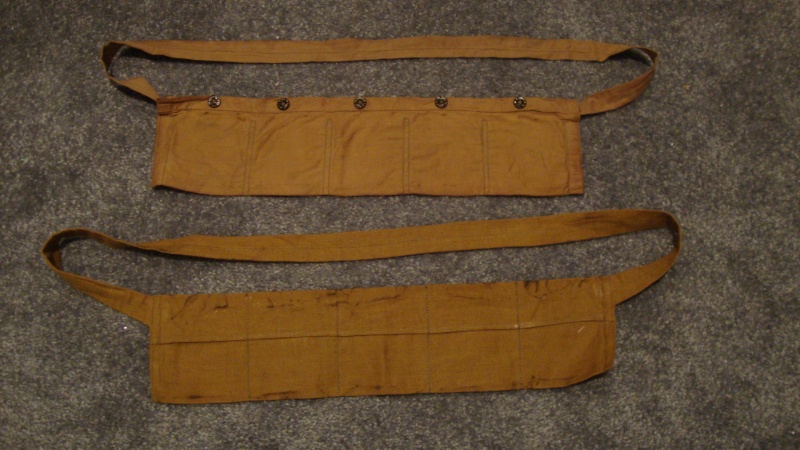
Close-up of S.A.A. Bandoliers
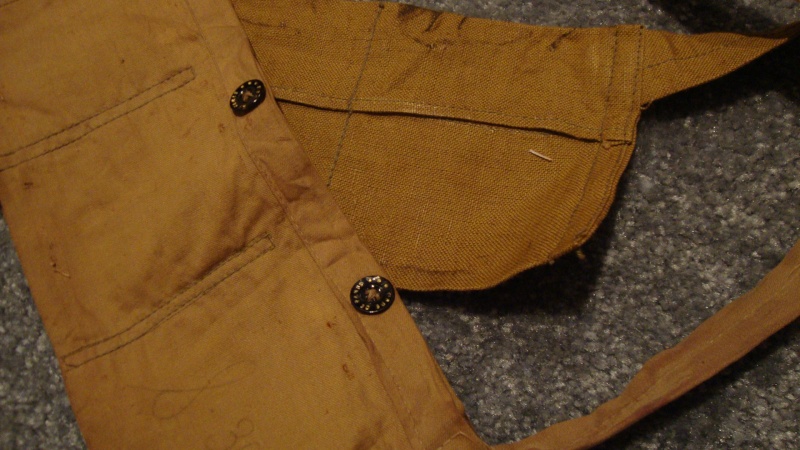
Complete set in Field Service Marching Order

Interior view

Basic pouches marked "Z.L.&T.LTD. 1942" - Note the ballistite loops

Right side - Note the 1-inch wide basic pouch closure strap and front closure water bottle carrier

Water bottle carrier marked "Z.L.&T.LTD. 1942"

Haversack marked "Z.L.&T.LTD. 1942"

Canadian mess tin cover in typical greenish shade of Canadian khaki drill

Canadian government ownership mark on mess tin cover

Mess tin cover made by TAPATCO and marked "THE AMERICAN PAD & TEXTILE CO. - CHATHAM - ONT. 1942"

Haversack interior showing dividers for mess tin/water bottle as well as the inspection/production number

Large pack marked "Z.L.&T.LTD. 1942"

Support straps marked "Z.L.&T.LTD. 1943"

Back of basic pouch showing "SMALL" marking

Belt Marked "Z.L.&T.LTD. 1942 - L - 56" - Note that large sized belts could accommodate sizes up to 56-inches

Bayonet frog made by Granby Elastic Webbing and marked "GEW 1942"

Left brace marked "Z.L.&T.LTD. 1942 - L"

Right brace marked "Z.L.&T.LTD. 1942 - R"

Left L-strap marked "Z.L.&T.LTD. 1942 - L"

Right L-strap marked "Z.L.&T.LTD. 1942 - R"

British & Canadian Emergency S.A.A. Bandoliers

Close-up of S.A.A. Bandoliers

Last edited by Wgrenadier on Sun Oct 20, 2013 3:19 am; edited 1 time in total

Wgrenadier- Moderator
- Posts : 289
Join date : 2013-02-16
Some pictures of an early war set of Canadian manufactured Officer's Pattern 1937 Webbing.
Exterior of set
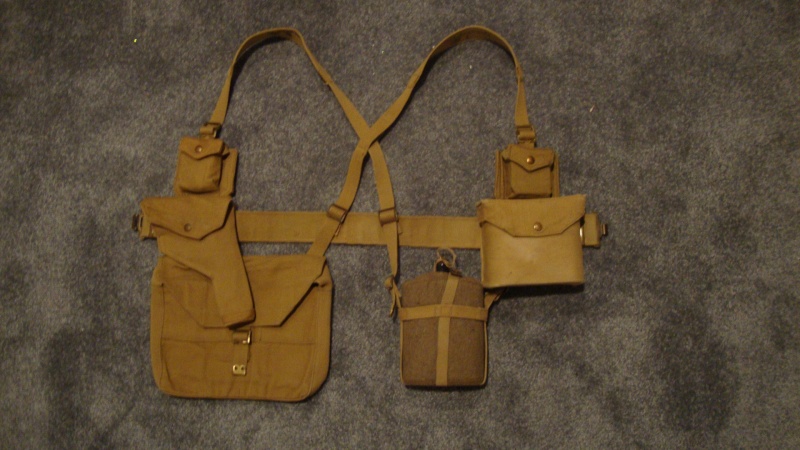
Interior of set
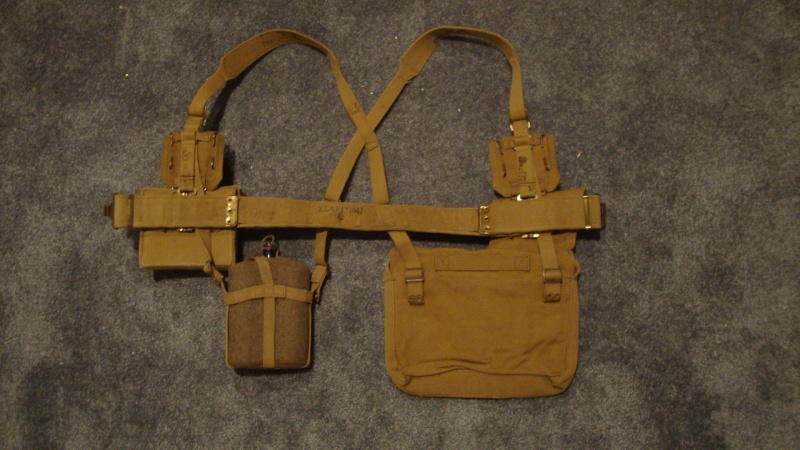
Belt marked "Z.L.&T.LTD. 1941 - L"
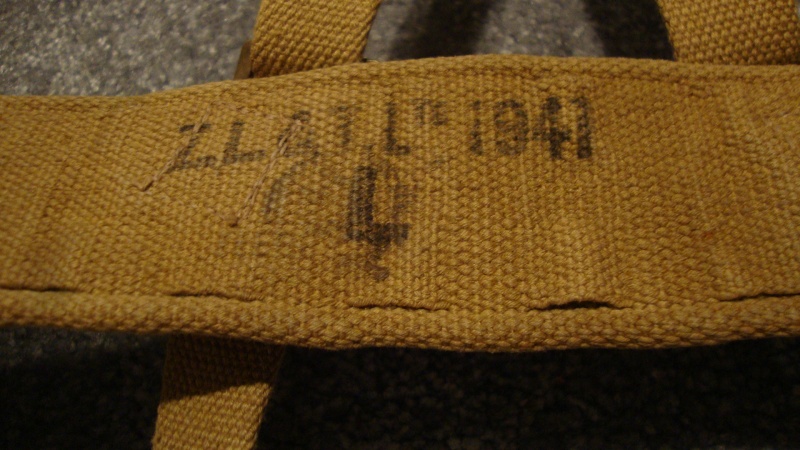
Water bottle Carrier marked "Z.L.&T.LTD. 1940" or "Z.L.&T.LTD. 1941" - Note the Canadian sold-out-of-service mark
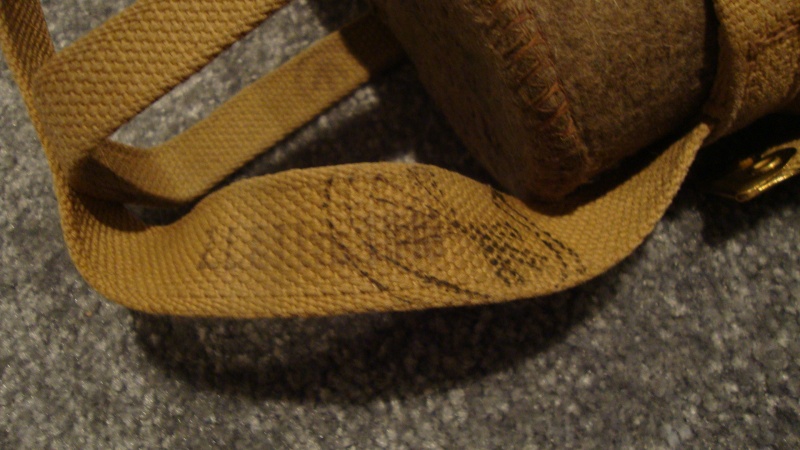
Brace attachment marked "Z.L.&T.LTD. 1943" - Note the later style 'solid bar' belt fitting
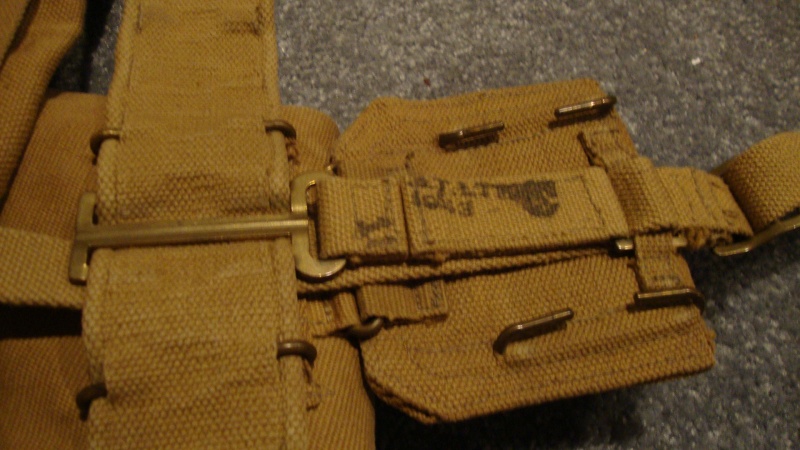
Right brace marked "Z.L.&T.LTD. 1942 - R"

Left brace marked "Z.L.&T.LTD. 1942 - L"

Right side of webbing showing the binocular case and compass pocket - Note the lack of buckles on the 1st pattern binocular case and the early top closure on the water bottle carrier
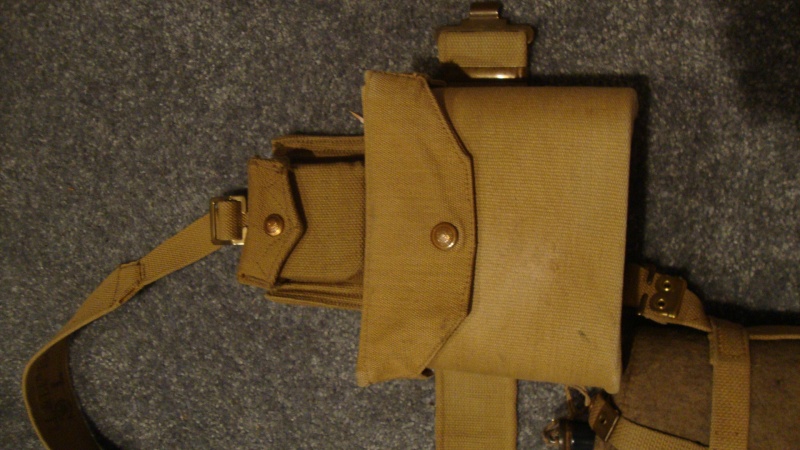
Binocular case marked "Z.L.&T.LTD. 1940"

Bausch & Lomb 6x30 binoculars with Canadian government ownership mark
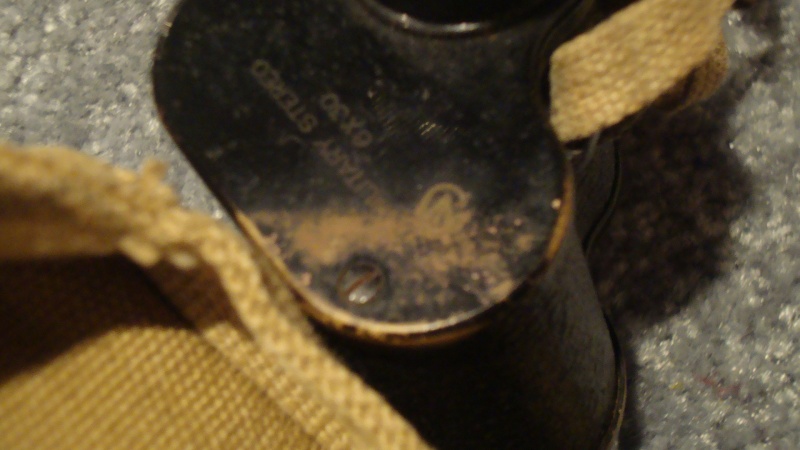
Compass pocket marked "Z.L.&T.LTD. 1940"
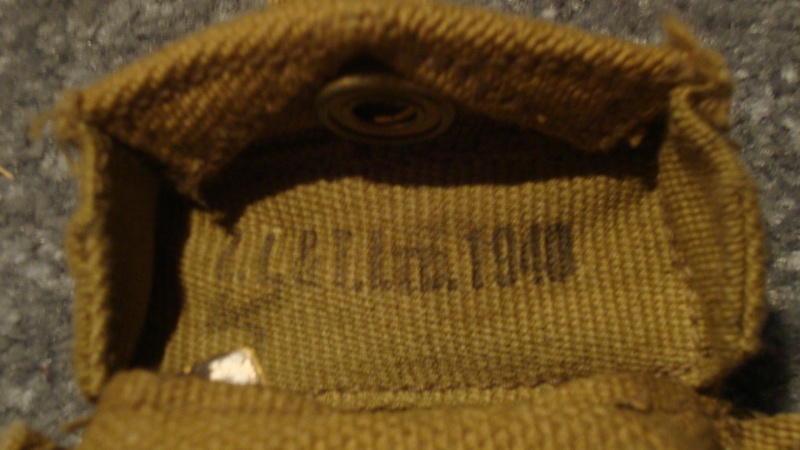
Left side of webbing showing the pistol case and pistol ammunition pouch - Note the box shape of the ammunition pouch (due to a lack of Canadian looms capable of integral weaving) as well as the 1st pattern Canadian holster
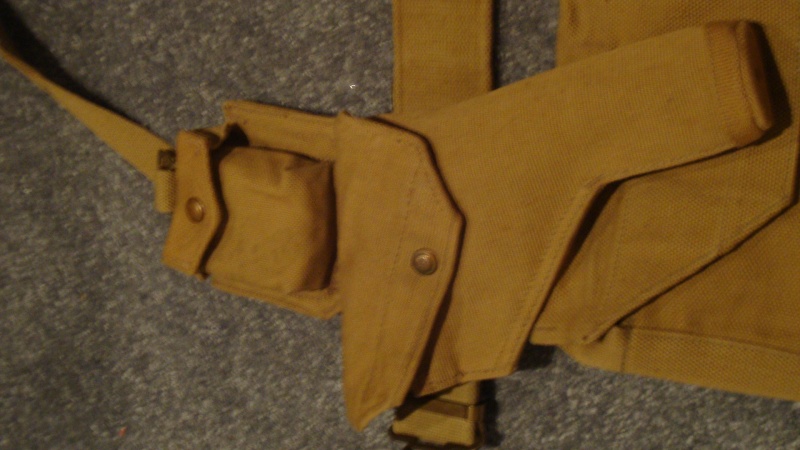
Pistol case marked "Z.L.&T.LTD. 1941"
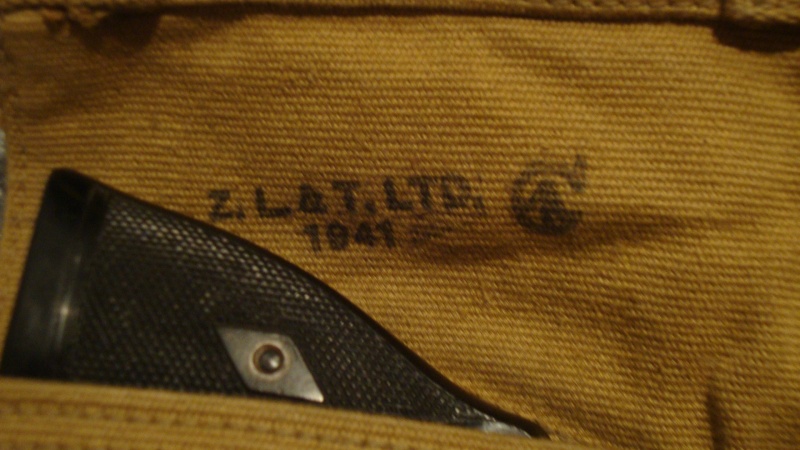
Pistol ammunition pouch marked "Z.L.&T.LTD. 1942"
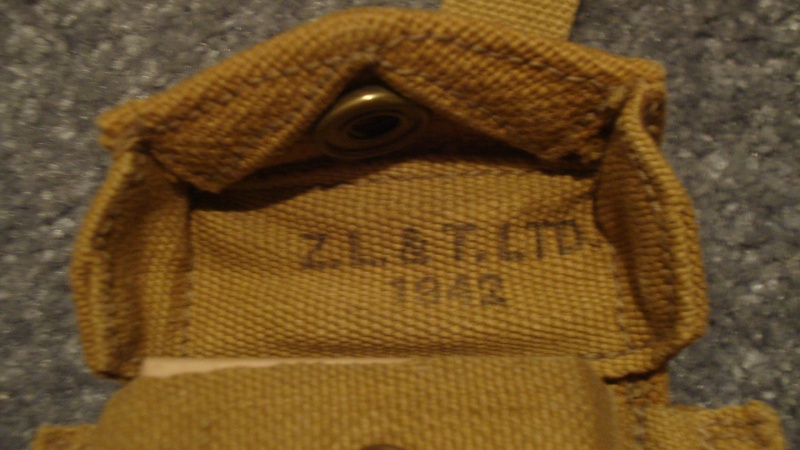
Officer's valise - Note that the closure strap is shorter than the British pattern

Officer's valise "Z.L.&T.LTD. 1941"
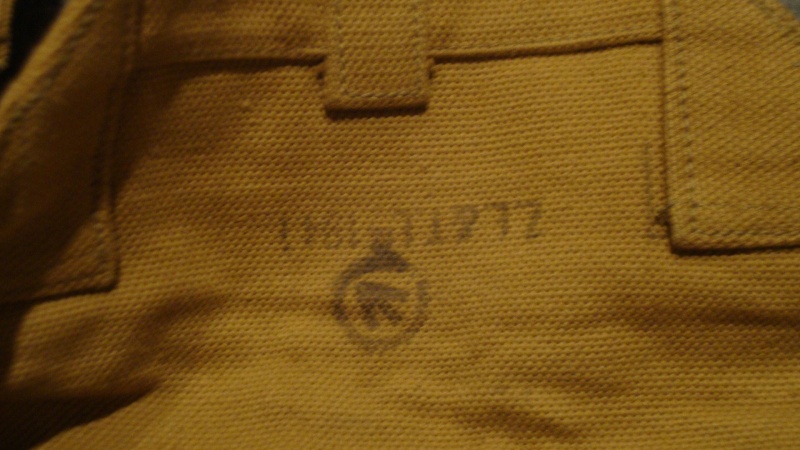
Interior snaps of officer's valise marked "UNITED - CARR"

Interior of Canadian snaps marked "UNITED CARR - CANADA" - Note that all snaps on this set are pebble grained

Exterior of set

Interior of set

Belt marked "Z.L.&T.LTD. 1941 - L"

Water bottle Carrier marked "Z.L.&T.LTD. 1940" or "Z.L.&T.LTD. 1941" - Note the Canadian sold-out-of-service mark

Brace attachment marked "Z.L.&T.LTD. 1943" - Note the later style 'solid bar' belt fitting

Right brace marked "Z.L.&T.LTD. 1942 - R"

Left brace marked "Z.L.&T.LTD. 1942 - L"

Right side of webbing showing the binocular case and compass pocket - Note the lack of buckles on the 1st pattern binocular case and the early top closure on the water bottle carrier

Binocular case marked "Z.L.&T.LTD. 1940"

Bausch & Lomb 6x30 binoculars with Canadian government ownership mark

Compass pocket marked "Z.L.&T.LTD. 1940"

Left side of webbing showing the pistol case and pistol ammunition pouch - Note the box shape of the ammunition pouch (due to a lack of Canadian looms capable of integral weaving) as well as the 1st pattern Canadian holster

Pistol case marked "Z.L.&T.LTD. 1941"

Pistol ammunition pouch marked "Z.L.&T.LTD. 1942"

Officer's valise - Note that the closure strap is shorter than the British pattern

Officer's valise "Z.L.&T.LTD. 1941"

Interior snaps of officer's valise marked "UNITED - CARR"

Interior of Canadian snaps marked "UNITED CARR - CANADA" - Note that all snaps on this set are pebble grained


48th- Member
- Posts : 287
Join date : 2012-12-05
Great examples there Wgrenadier. You have a very nice collection.

Wgrenadier- Moderator
- Posts : 289
Join date : 2013-02-16
Thanks 48th!
I know you have a lot of early production webbing as well…have you ever noticed that examples made in 1940 are darker khaki (closer to the British shade of khaki) than the normal golden shade of later Canadian webbing?
I also have an unissued ZL&T Canadian pistol case dated 1940 in a bizarre greenish-gold shade that doesn’t match anything, so perhaps Canadian manufacturers were experimenting with the dying process in that year…
I know you have a lot of early production webbing as well…have you ever noticed that examples made in 1940 are darker khaki (closer to the British shade of khaki) than the normal golden shade of later Canadian webbing?
I also have an unissued ZL&T Canadian pistol case dated 1940 in a bizarre greenish-gold shade that doesn’t match anything, so perhaps Canadian manufacturers were experimenting with the dying process in that year…

zekehp- Member
- Posts : 128
Join date : 2011-07-23
Age : 66
Location : Niagara Falls On.
Everything is in excellent condition. I'm jealous.

Wgrenadier- Moderator
- Posts : 289
Join date : 2013-02-16
Thanks for the nice words! You know that I owe my early basic pouches, frog, support straps, etc to you though! These pictures are a bit old and don’t reflect the new additions.zekehp wrote:Everything is in excellent condition. I'm jealous.
I really appreciate your help with my collecting!

48th- Member
- Posts : 287
Join date : 2012-12-05
Hi Wgrenadier,
As you know I have an almost complete set of Z.L.& T. 1940 P37 webbing and yes I have defiantly noticed a considerable difference in the color of some of the 1940 dated Canadian webbing. I would consider Canadian made P37 WWII dated webbing to have an orange hue to it.
I have a large pack that if you did not see the maker marks you would think that it was British made, it is considerably more beige in color with a courser weave to it.
I also have seen mint unissued 1940 dated webbing with the greenish tint that you mentioned as well. It seems the makers marks and date stamps are inconsistent as well ranging from small to large font stampings and extremely dark to faint.
1940 was the first year that P37 webbing was manufactured in Canada and it stands to reason that there would be some growing pains with material suppliers and the manufacturing process in the factory resulting in some inconsistencies. It is my feeling that all the inconsistency we see with 1940 dated webbing took place early in the production year and were corrected later in the year. Another good example of this is the 1940 dated binocular case having no buckles on some 1940 dated cases and some do.
As always Wgrenadier you have contributed great information to this site and I am sure it has helped a lot of collectors learn some thing including my self, keep up the good work.
Judging from the Canadian produced webbing I have seen the inconsistency issues were fixed by 1941.
Wgrenadier wrote:Thanks 48th!
I know you have a lot of early production webbing as well…have you ever noticed that examples made in 1940 are darker khaki (closer to the British shade of khaki) than the normal golden shade of later Canadian webbing?
I also have an unissued ZL&T Canadian pistol case dated 1940 in a bizarre greenish-gold shade that doesn’t match anything, so perhaps Canadian manufacturers were experimenting with the dying process in that year…

Wgrenadier- Moderator
- Posts : 289
Join date : 2013-02-16
Hi 48th,
I'm glad someone else has noticed the variation in color of early Canadian webbing and it's not just my imagination! I wonder if the greenish webbing was designed to match the greenish Canadian khaki drill?
Regardless of color variation in the first production year, Canada's overnight webbing industry was incredible! I believe Canadian webbing easily matches/exceeds British webbing for quality and uniformity...then again, Canada's webbing manufacturers didn't have to worry about nightly air raids!
I'm glad someone else has noticed the variation in color of early Canadian webbing and it's not just my imagination! I wonder if the greenish webbing was designed to match the greenish Canadian khaki drill?
Regardless of color variation in the first production year, Canada's overnight webbing industry was incredible! I believe Canadian webbing easily matches/exceeds British webbing for quality and uniformity...then again, Canada's webbing manufacturers didn't have to worry about nightly air raids!




